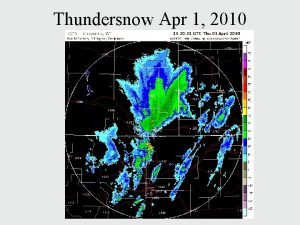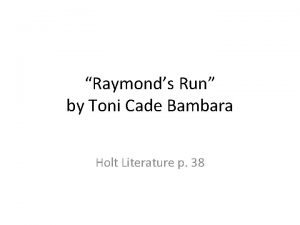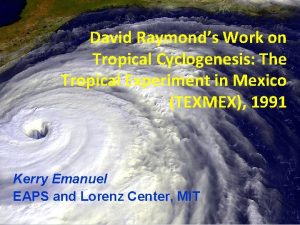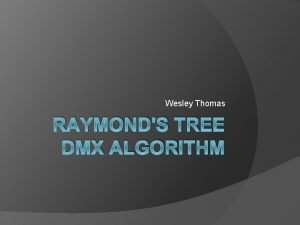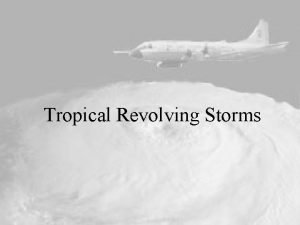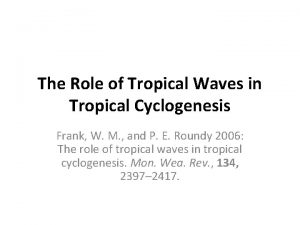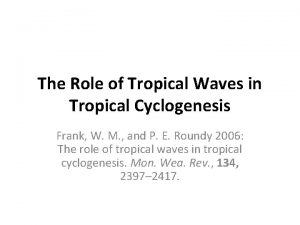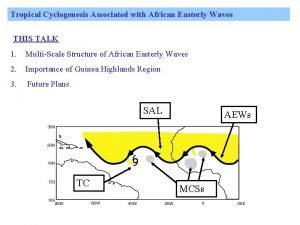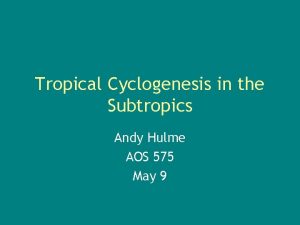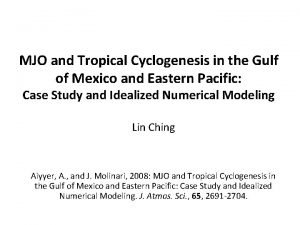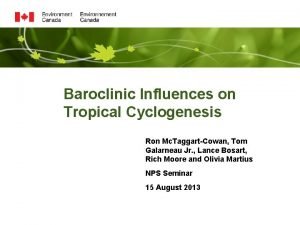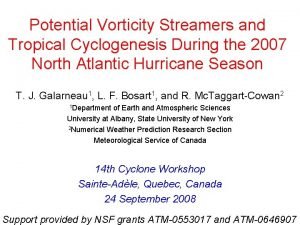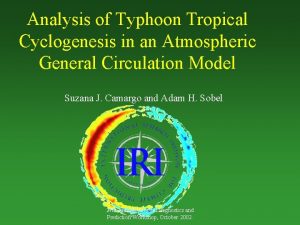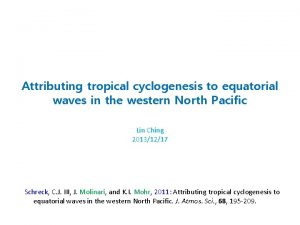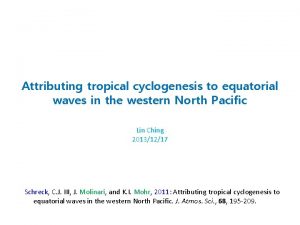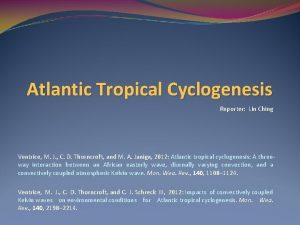David Raymonds Work on Tropical Cyclogenesis The Tropical
















- Slides: 16

David Raymond’s Work on Tropical Cyclogenesis: The Tropical Experiment in Mexico (TEXMEX), 1991 Kerry Emanuel EAPS and Lorenz Center, MIT

Program The historical context Research leading up to TEXMEX, 1991 The TEXMEX project What we learned Recap of Dave Raymond’s contributions to the tropical cyclone research

Two Distinct Threads of Genesis Theories

TC formation as a mode of release of conditional instability Espy (1841), The Philosophy of Storms Palmén (1948), On the formation and structure of tropical hurricanes Charney and Eliassen (1964): On the growth of the hurricane depression Yamasaki (1968): Numerical simulation of tropical cyclone development with the use of primitive equations Example: Numerous cumulonimbus clouds warm and gradually moisten their environment. This warming…produces a pressure fall at the surface, because warm air weighs less than cool air. The slowly converging horizontal winds near the surface respond to this slight drop of pressure by accelerating inward. But the increased inflow produces increased lifting, so that the thunderstorms become more numerous and intense. The feedback loop is now established. -- from a textbook published in the late 1970 s

Already in 1901 Julius von Hann voiced an objection: “Since a thundercloud does not give any appreciable pressure fall [at the surface] but even a pressure rise, it would be unreasonable to assume that a magnifying of this process would cause the strongest pressure falls known” -- As paraphrased by Bergeron, QJRMS, 1954

Diagram from Bergeron, QJRMS, 1954 z x y x

TC formation as a flux-driven phenomenon Riehl (1950): A model for hurricane formation Kleinschmidt (1951): Principles of theory of tropical cyclones (in German) Ooyama (1969): Numerical simulation of the life cycle of tropical (Note: A foot in both camps) cyclones Rosenthal (1971): The response of a tropical cyclone model to variations in boundary layer parameters, initial conditions, lateral boundary conditions, and domain size Gray (1975): Tropical Cyclone Genesis. (First to note role of cloudradiation interactions) Example: The heat removed from the sea by the storm is the basic energy source of typhoon. In comparison to it, the latent heat of the water vapour, which the air carries with it from the outside, plays no more than a secondary role. - Ernst Kleinschmidt, 1951

Simulations Using Balanced Axisymmetric Model

Saturate troposphere inside 100 km in initial state:





Self-Aggregation on an f-plane Vincent Van Gogh: Starry Night

David Raymond’s Published Research on Tropical Cyclones Raymond, D. J. , 1992: Nonlinear Balance and Potential Vorticity Thinking at Large Rossby Number. QJRMS 116, D 18101, doi: 10. 1029/2011 JD 015624 Raymond, D. J. , and S. A. Lewis, 1995: Rotating convective disturbances in the trades, Quart. J. Roy. Meteor. Soc. , 121, 271 -299. Raymond, D. J. , C. Lopez-Carrillo, and L. Lopez Cavazos, 1998: Case-studies of developing east Pacific easterly waves. Quart. J. Roy. Meteor. Soc. , 124, 2005 -2034 Raymond, D. J. , and S. L. Sessions, 2007: Evolution of convection during tropical cyclogenesis, Geophys. Res. Lett. , 34, L 06811, doi: 10. 1029/2006 GL 028607 Raymond, D. J. , S. Sessions, and Z. Fuchs, 2007: A theory for the spinup of tropical depressions, Quarterly Journal of the Royal Meteorological Society, 133, 1743 -1754 Marin, J. C. , D. J. Raymond, and G. B. Raga, 2009: Intensification of tropical cyclones in the GFS model. Atmos. Chem. Phys. , 9, 1407 -1417 Raymond, D. J. and C. Lopez Carrillo, 2011: The vorticity budget of developing typhoon Nuri (2008), Atmos. Chem. Phys. , 11, 147 -163, doi: 10. 5194/acp-11 -147 -2011

Raymond, D. J. , 2012: Balanced thermal structure of an intensifying tropical cyclone. Tellus. A, 64, 19181, doi. org/10. 3402/tellusa. v 64 i 0. 19181 Gjorgjievska, S. and D. J. Raymond, 2014: Interaction between dynamics and thermodynamics during tropical cyclogenesis, Atmos. Chem. Phys. , 14, 3065 -3082 Raymond, D. J. , S. Gjorgjievska, S. Sessions, and Z. Fuchs, 2014: Tropical cyclogenesis and mid-level vorticity. Australian Meteorological and Oceanographic Journal, 64, 11 -25 Fuchs, Z, M. J. Herman, and D. J. Raymond, 2014: Frictional convergence in a decaying weak vortex, J. Atmos. Sci. , 71, 2467 -2475 Juracic, A. , and D. J. Raymond, 2016: The effects of moist entropy and moisture budgets on tropical cyclone development. J. Geophys. Res. , 121, 9458 -9473
 Cyclogenesis stages
Cyclogenesis stages Cyclogenesis occurs along the________.
Cyclogenesis occurs along the________. Raymond's run characters
Raymond's run characters Setting of raymond's run
Setting of raymond's run Characters in raymond's run
Characters in raymond's run Hazel elizabeth deborah parker
Hazel elizabeth deborah parker Hát kết hợp bộ gõ cơ thể
Hát kết hợp bộ gõ cơ thể Slidetodoc
Slidetodoc Bổ thể
Bổ thể Tỉ lệ cơ thể trẻ em
Tỉ lệ cơ thể trẻ em Chó sói
Chó sói Tư thế worms-breton
Tư thế worms-breton Chúa sống lại
Chúa sống lại Các môn thể thao bắt đầu bằng tiếng nhảy
Các môn thể thao bắt đầu bằng tiếng nhảy Thế nào là hệ số cao nhất
Thế nào là hệ số cao nhất Các châu lục và đại dương trên thế giới
Các châu lục và đại dương trên thế giới Công thức tiính động năng
Công thức tiính động năng
